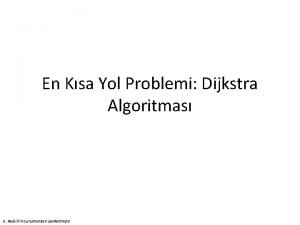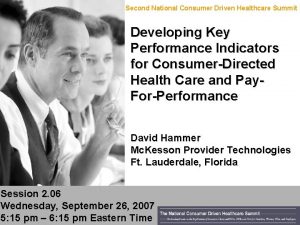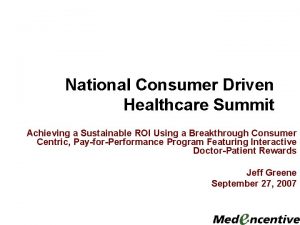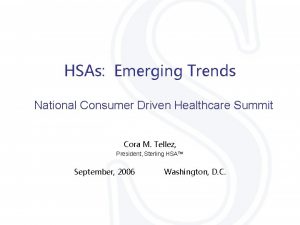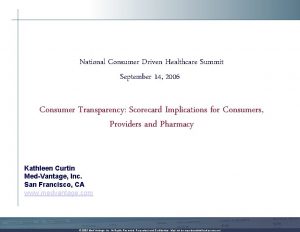The Future of Consumer Driven Healthcare Washington D















- Slides: 15

The Future of Consumer Driven Healthcare Washington, D. C. February 16, 2010 Ronald E. Bachman FSA, MAAA President & CEO Healthcare Visions 404 -697 -7376 0

Healthcare Consumerism the Key to Cost Control “Only Consumers Can Bend the Cost Curve” - CAHI Have we Lost the American Character of Personal Responsibility? 1

Creating a Healthcare Strategy Starts with a Clear Vision The Missing Link Desire for Change + A Common Vision Future State + Process for Change = POSITIVE CHANGE + Process for Change = Expensive False Starts A Vision for Transformation NOT Cost Shifting, Tweaking, or Reform 2

Your Choice: Supply Controls or Demand Controls? Plan Sponsors and Members have two basic choices to control costs: 1. Managed care & HMOs - The “supply of care” is limited by a third party who controls the access to medical services (e. g. utilization reviews, medical necessity, gatekeepers, formularies, scheduling, types of services allowed), or 2. Consumerism - The member controls their “demand for care” because of a direct and significant financial involvement in the cost of care, rewards for compliance, and the information to make wise health and healthcare value driven decisions. 3

Mega Trends Creating Demand Control Initiatives 1. Personal Responsibility 2. Self-Help, Self-Care, Self Reliance 3. Individual Ownership 4. Portability 5. Transparency (the Right to Know) 6. Consumerism (Empowerment) 4

Healthcare Consumerism is about transforming a health benefit plan into one that puts economic purchasing power—and decision-making—in the hands of participants. It’s about supplying the information and decision support tools they need, along with financial incentives, rewards, and other benefits that encourage personal involvement in altering health and healthcare purchasing behaviors. 5

The Core of Consumerism The Unifying Themes For Healthcare Consumerism is: Personal Responsibility & Behavioral Change “Implement only if it supports behavioral change consistent with the strategy” 6

The Evolution of Healthcare Consumerism Future Generations of Consumerism Traditional Plans 1 st Generation 2 nd Generation 3 rd Generation Traditional Consumerism Plans with Integrated Focus on Consumer Health & Discretionary Behavior Information Performance Spending Changes 4 th Generation Consumerism Personalized Health & Healthcare Behavioral Change and Cost Management Potential Low Impact ---- ---- ---- High Impact 7

The Promises of Consumerism Major Building Blocks of Consumerism Personal Care The Promise of Demand Control & Savings Accounts Wellness/Preventi The Promise of Wellness on Early Disease and Case Intervention Management Information Decision Support Incentives & The Promise of Health The Promise of Transparency The Promise of Shared Savings It is the creative development, efficient delivery, efficacy, and successful integration of these elements that will prove the success or failure of consumerism. Rewards 8

The Consumerism Grid Personal Care Accounts Wellness/Preventi on Early Disease and Case 1 st Generation Consumerism 2 nd Generation Consumerism 3 rd Generation Consumerism Focus on Discretionary Spending Focus on Behavior Changes Integrated Health & Performance Initial Account Only Activity & Compliance Rewards Indiv. & Group Corporate Metric Rewards 4 th Generation Consumerism Personalized Health & Healthcare Specialized Accts, Matching HRAs, Expanded QME Web-based Worksite wellness, Genomics, 100% Basic behavior change safety, stress & error predictive modeling Preventive Care support programs reduction push technology Intervention Management Information, health coach Information Passive Info Discretionary Expenses Compliance Population Mgmt, Wireless cyber – Awards, disease Integrated Hlth Mgmt, support, cultural specific allowances Integrated Back-to. DM, Holistic care Work Personal health Health & performance Arrive in time info, mgmt, info with info, integrated health info therapy, social incentives to access work data networks Cash, tickets, Trinkets Health Incentive Non-health corporate Accounts, activity metric driven based incentives Decision Support Incentives & Rewards Personal dev. plan incentives, health status related

Integrated Health Management Program An Implementation Option for Multiple Generations General Manager s Pro tric Integrated Absence Mgmt on & se ou reh i rat Demand Management teg Disease Mgmt Programs In ss Me Acute Case Mgmt ce Da Dis ta & Wa The secret is cooperation and synergy between components supporting the corporate strategies Personal Care Accts. FSAs, HRAs, HSAs ny pa lin cip Prevention nt NETWORK B / TPA B me NETWORK A / TPA A ve Utilization and Case Management pro Im C om ed Wellness 10

Potential Savings from Full Implementation of Consumerism Achievement of savings and improved outcomes is dependent upon both the Type and Effectiveness of the programs implemented. Gross* Savings as % of Total Plan Costs (Programs Applicable to All Members) Traditional plans Effective Programs Implemented Consumerism Plans Passive 1 st Generation 2 nd Generation 3 rd Gen & Future Basic 2% 3% 7% 10% Expanded 3 -4% 5 -8% 12 -15. 0% 20. 0+% Complete 4% 7% 17% 25% Comprehensive (Future) 5% 10% 20% 30% *Excludes Carry-over HRAs/HSAs and any added Administrative Costs of Specialized Programs 11

American Academy of Actuaries 2009 Non-partisan CDH Consumerism Studies • 1 st Year Savings: The total savings generated could be as much as 12 percent to 20 percent in the first year. – All studies showed a drop in costs in the first year of a CDH plan from -4 percent to -15 percent. A control population of traditional plans experienced increases of +8 percent to +9 percent. • 2+ Year Savings: At least two of the studies indicate trend rates lower than traditional PPO plans by approximately 3 percent to 5 percent. – If these lower trends can be further validated, it will represent a substantial cost-reduction strategy for employers and employees. • Cost Shifting: The studies indicated that while the possibility for employer cost-shifting exists with CDH plans, (as it does with traditional plans) most employers are not doing so, and might even be reducing employee cost-sharing under certain circumstances. 12

AAA Consumerism Study – Quality of Care • Preventive Care: All of the studies reviewed reported a significant increase in preventive services for CDH participants. • Chronic Care: Three of the studies found that CDH plan participants received recommended care for chronic conditions at the same or higher level than traditional (non-CDH) plan participants. • Physician Treatments: Two studies reported a higher incidence of physicians following evidence-based care protocols. • Care Avoidance: All of the studies indicated that cost savings did not result from avoidance of inappropriate care and that necessary care was received in equal or greater degrees relative to traditional plans. 13

Circle of Life How Long Do We Have? 1. From bondage to spiritual faith; 2. From spiritual faith to great courage; 3. From courage to liberty; 4. From liberty to abundance; 5. From abundance to complacency; 6. From complacency to apathy; 7. From apathy to dependence; 8. From dependence back into bondage 14
 Primary consumers and secondary consumers
Primary consumers and secondary consumers Future perfect continuous tense example
Future perfect continuous tense example Future perfect simple vs future perfect continuous
Future perfect simple vs future perfect continuous Healthcare and the healthcare team chapter 2
Healthcare and the healthcare team chapter 2 Healthcare and the healthcare team chapter 2
Healthcare and the healthcare team chapter 2 Molina medicare washington
Molina medicare washington Dijkstra algoritması
Dijkstra algoritması Consumer driven contract testing
Consumer driven contract testing Chapter 5 consumer markets and buyer behavior
Chapter 5 consumer markets and buyer behavior Greenfly carnivore
Greenfly carnivore Consumer markets and consumer buyer behavior
Consumer markets and consumer buyer behavior Consumer diversity in consumer behaviour
Consumer diversity in consumer behaviour Consumer research process
Consumer research process See future continuous
See future continuous Present past future simple continuous perfect
Present past future simple continuous perfect Future tenses summary
Future tenses summary






